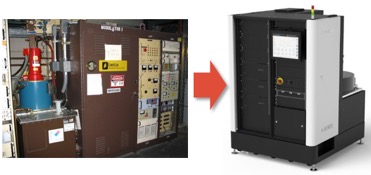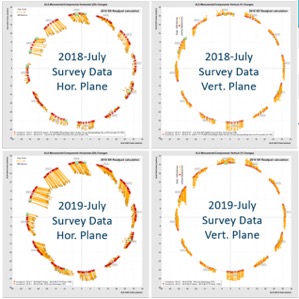The upcoming 2020 ALS long shutdown starting in July includes a number of projects targeting improvements to the ALS accelerators’ reliability and performance—two factors of paramount importance. In planning projects for upcoming shutdowns, the ALS has made an effort to minimize disruption to users, first by breaking down projects into the smallest possible segments to take the least amount of time, and second by conducting projects in parallel when possible. The present plan—which will be finalized in the next few months—for a 12-week shutdown (including beam startup time) will allow for the completion of two main tasks, the replacement of the linac (linear accelerator) high-power modulators, and the realignment of the storage ring (and of the beamlines when necessary).

The ALS linac is composed of two accelerating sections whose radio frequency (RF) power is generated by individual klystron/modulator systems. The klystron is a high power RF amplifier that requires high voltage (~200 kV), high current (~250 A) pulses (~2.5 us at 10 Hz repetition rate) to operate. The modulator is the device that generates such pulses. The present ALS modulators are the legacy ones installed during the ALS’s first commissioning in 1993. They are based on obsolete technology and are showing signs of aging that could soon start degrading the ALS reliability. New state-of-the-art commercial modulators have been ordered and will be delivered in the spring for their installation in the ALS during the Summer 2020 shutdown.
In the last several years, we have been surveying the position of the ALS storage ring components to evaluate the need of a global realignment of the ring. This strategy allowed us to postpone this time-consuming and cumbersome operation (also for beamlines) for a number of years. Nevertheless, the results from the last survey indicated that it is now time for a ring realignment, leading us to schedule it for the Summer 2020 shutdown.


Besides the two main items driving the duration of the shutdown, a number of additional tasks and activities are planned for the Summer 2020 shutdown. In particular for its potential benefit to users, we will be upgrading the fast orbit feedback to increase its bandwidth from the present hundred Hz to kHz-class. This performance upgrade will allow the controlling of the electron beam position in the ring—and ultimately the photon position in the beamlines—with a much-increased accuracy, in particular reducing the 60 and 120 Hz noise lines associated with the AC power distribution. The fast orbit feedback upgrade is a multi-faceted project that includes:
- installation of more than 100 new digital beam position monitors and their controllers (already installed and successfully commissioned at the ALS);
- several tens of new corrector magnet power supplies capable of the fast magnetic field variations necessary to control the beam position with at kHz frequency rate (the units are being installed in the ring);
- more than 20 new stainless steel spool piece vacuum chambers replacing the existing aluminum vacuum chambers inside the correctors. The lower conductivity chambers are more transparent to fast variation of the magnetic field and are necessary to increase the feedback bandwidth. Half of the chambers have already been installed.
Finally, users will notice a change in the landscape after the summer shutdown. Building 7 is scheduled for demolition in July